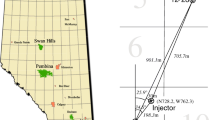Abstract
The efficiency and sustainability of carbon dioxide (CO2) storage in deep geological formations crucially depends on the integrity of the overlying cap-rocks. Existing oil and gas wells, which penetrate the formations, are potential leakage pathways. This problem has been discussed in the literature, and a number of investigations using semi-analytical mathematical approaches have been carried out by other authors to quantify leakage rates. The semi-analytical results are based on a number of simplifying assumptions. Thus, it is of great interest to assess the influence of these assumptions. We use a numerical model to compare the results with those of the semi-analytical model. Then we ease the simplifying restrictions and include more complex thermodynamic processes including sub- and supercritical fluid properties of CO2 and non-isothermal as well as compositional effects. The aim is to set up problem-oriented benchmark examples that allow a comparison of different modeling approaches to the problem of CO2 leakage.
Similar content being viewed by others
References
Assteerawatt, A., Bastian, P., Bielinski, A., Breiting, T., Class, H., Ebigbo, A., Eichel, H., Freiboth, S., Helmig, R., Kopp, A., Niessner, J., Ochs, S.O., Papafotiou, A., Paul, M., Sheta, H., Werner, D., Ölmann, U.: MUFTE-UG: structure, applications and numerical methods. Newsletter, International Groundwater Modeling Centre, Colorado School of Mines 23(2), (10/2005)
Bastian, P., Helmig, R.: Efficient fully-coupled solution techniques for two phase flow in porous media. Parallel multigrid solution and large scale computations. Adv. Water Resour. 23, 199–216 (1999)
Batzle, M., Wang, Z.: Seismic properties of pore fluids. Geophysics 57, 1396–1408 (1992)
Bielinski, A.: Numerical simulation of CO2 sequestration in geological formations. PhD thesis, Universität Stuttgart (2006)
Brooks, A.N., Corey, A.T.: Hydraulic properties of porous media. In: Hydrol. Pap. Fort Collins, Colorado State University (1964)
Class, H., Helmig, R., Bastian, P.: Numerical simulation of non-isothermal multiphase multicomponent processes in porous media. – 1. An efficient solution technique. Adv. Water Resour. 25, 533–550 (2002)
Class, H., Helmig, R., Niessner, J., Ölmann, U.: Multiphase Processes in Porous Media, Multifield Problems in Solid and Fluid Mechanics, 28th edition, pp. 45–82. Springer, Berlin Heidelberg New York (2006)
Daubert, T.E., Danner, R.P.: Physical and thermodynamic properties of pure chemicals: data compilation. Design Institute for Physical Property Data (1989)
Duan, Z., Sun, R.: An improved model calculating CO2 solubility in pure water and aqueous NaCl solutions from 273 to 533 K and from 0 to 2000 bar. Chem. Geol. 193, 257–271 (2003)
Fenghour, A., Wakeham, W., Vesovic, V.: The viscosity of carbon dioxide. J. Phys. Chem. Ref. Data 27(1), 31–44 (1998)
Garcia, J.: Density of aqueous solutions of CO2. Technical report, LBNL Report 49023, Lawrence Berkeley National Laboratory, Berkeley, CA, USA (2001)
Gasda, S., Bachu, S., Celia, M.: Spatial characterization of the location of potentially leaky wells penetrating a deep saline aquifer in a mature sedimentary basin. Environ. Geol. 46, 707–720 (2004)
Helmig, R.: Multiphase Flow and Transport Processes in the Subsurface. Springer, Berlin Heidelberg New York (1997)
Helmig, R., Class, H., Huber, R., Sheta, H., Ewing, R., Hinkelmann, R., Jakobs, H., Bastian, P.: Architecture of the modular program system MUFTE-UG for simulating multiphase flow and transport processes in heterogeneous porous media. Math. Geol. 2, 123–131 (1998)
Holloway, S.: Storage of fossil fuels-derived carbon dioxide beneath the surface of the earth. Ann. Rev. Energy Environ. 26, 145–166 (2001)
Huber, R., Helmig, R.: Node-centered finite-volume discretization for the numerical simulation of multiphase flow in heterogeneous porous media. Comput. Geosci. 4, 141–164 (2000)
IAPWS: Release on the IAPWS Industrial Formulation 1997 for the Thermodynamic Properties of Water and Steam. The International Association for the Properties of Water and Steam (1997) http://www.iapws.org/.
Michaelides, E.: Thermodynamic properties of geothermal fluids. Geotherm. Resour. Counc. Trans. 5, 361–364 (1981)
Nordbotten, J., Celia, M., Bachu, S.: Analytical solutions for leakage rates through abandoned wells. Water Resour. Res. 40(4), W04204 (2004)
Nordbotten, J., Celia, M., Bachu, S.: Injection and storage of CO2 in deep saline aquifers: analytical solution for CO2 plume evolution during injection. Transp. Porous Media 58(3), 339–360 (2005a)
Nordbotten, J., Celia, M., Bachu, S., Dahle, H.: Semi-analytical solution for CO2 leakage through an abandoned well. Environ. Sci. Technol. 39(2), 602–611 (2005b)
Oldenburg, C., Pruess, K., Benson, S.: Process modeling of CO2 injection into natural gas reservoirs for Carbon sequestration and enhanced gas recovery. Energy Fuels 15(2), 293–298 (2001)
Pruess, K.: Thermal effects during CO2 leakage from a geologic storage reservoir. Lawrence Berkeley National Laboratory Report LBNL-55913 (2004)
Pruess, K., Bielinski, A., Ennis-King, J., Fabriol, R., Le Gallo, Y., Garcia, J., Jessen, K., Kovscek, T., Law, D.-S., Lichtner, P., Oldenburg, C., Pawar, R., Rutqvist, J., Steefel, C., Travis, B., Tsang, C.-F., White, S., Xu, T.: Code intercomparison builds confidence in numerical models for geologic disposal of CO2. In: Gale, J., Kaya, Y. (eds.) GHGT-6 Conference Proceedings: Greenhouse Gas Control Technologies, pp. 463–470 (2003)
Pruess, K., Garcia, J.: Multiphase flow dynamics during CO2 injection into saline aquifers. Environ. Geol. 42, 282–295 (2002)
Span, R., Wagner, W.: A new equation of state for carbon dioxide covering the fluid region from the triple-point temperature to 1100 K at pressures up to 800 MPa. J. Phys. Chem. Ref. Data 25(6), 1509–1596 (1996)
Author information
Authors and Affiliations
Corresponding author
Rights and permissions
About this article
Cite this article
Ebigbo, A., Class, H. & Helmig, R. CO2 leakage through an abandoned well: problem-oriented benchmarks. Comput Geosci 11, 103–115 (2007). https://doi.org/10.1007/s10596-006-9033-7
Received:
Accepted:
Published:
Issue Date:
DOI: https://doi.org/10.1007/s10596-006-9033-7




